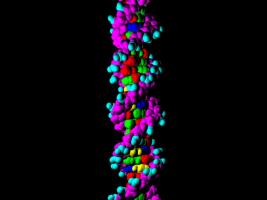-
Posts
779 -
Joined
-
Last visited
Content Type
Profiles
Forums
Events
Everything posted by Julian
-
It looks like the action doesn't open correctly in 12.0h for Mac, but it's okay in v11. I've updated the image attached to the first post with a render made in v11. Would anyone else care to try opening the project?
-
Hmm... there seems to be something wrong with the way the action was set up when I converted it from the v9.5 format: the bases aren't lining up properly. I don't know if I'll be able to fix it.
-
I'm making this DNA molecule project available in response to this thread. It's a little tricky to work with: the four nucleotides are different models, with each atom modeled as an eight-patch sphere. There's a separate model for the skeleton of a seven-base pair double helix composed of non-rendering splines, with an action that adds the nucleotides to it as action objects. The choreography contains three instances of the helix stacked on top of each other, with the bottom two instances having "translate to" and "orient like" constraints to the top instance. Basically, this molecule has a strand that repeats the sequence GATTACA three times, together with its complement. The color scheme is as follows: adenine is green, thymine is red, guanine is blue, cytosine is yellow, deoxyribose is magenta, phosphate is cyan. DNA_Molecule.zip
-
For those of you who want to work on high-rise buildings, have you thought about doing variable numbers of floors? You could have one model for the ground floor, one model for a middle floor, and one model for the top floor or roof, and then constrain them together in the choreography with multiple instances of the middle floor model. Alternatively, the ground floor could be the base model, and all the floors above it can be action objects. You could make different actions to produce different numbers of floors.
-
Why does the alignment fall apart like that after a couple of bounces? Rounding errors?
-
That's the thing, I'm not using multipass, and the render settings are exactly the same in both versions. This camera has a 30 mm lens, so it's pretty wide angle already. I'd do that if I were animating the shot, but right now it's taking me 3 hours just to render one frame, and I think the total amount of time to render the layers separately is going to work out about the same.
-
You would need to add a decal containing three images: a bump map with black text on a white background to make the text look recessed, an ambiance map with white text on a black background to make it glow, and a color map with text in a lava pattern and an alpha channel that makes its background transparent.
-
For comparison, here's the rendering from 11.1i. The 12.0e rendering shows much sharper markings on the ship's hull, and the projection map for the cloud patterns on Jupiter is properly antialiased, but like I said, it takes over six times as long to render, and I don't know why.
-
This is an improved, higher resolution version of my 2nd place winning entry for the July 2004 Sci-Fi/Fantasy image contest. The original version can be seen here on A:M Stills. I've tried rendering this scene in both A:M version 11.1i and 12.0e. The rendering done in 12.0e, shown in this post, has much better quality image maps, but it took me over three hours to render it in 12.0e as opposed to 22 minutes in 11.1i. Can anything be done about that?
-
I'm glad people are still interested in this! Would this have something to do with the Mars image contest?
-
-
Are you using any Fresnel reflectivity on the paintwork? It might need some to sell the car paint look. You could also do what professional car photographers do and set up some light panels behind the camera to provide something to reflect. These would just be single rectangular patches with a gradient that goes from white at the top to black at the bottom.
-
Colin, what kind of material settings did you use for the paint job? Is there some kind of light box behind the camera that the body can reflect off of? Also, did you do anything special for the headlamps, or is it just chrome and refractions?
-
It looks like he switched to using raytraced shadows instead of Z-buffered.
-

What would be the best way to about adding exhust
Julian replied to Phil's topic in Work In Progress / Sweatbox
If you want to avoid the particles falling upward as the plane descends, you have to make sure the velocity of the particles that make up the exhaust is greater than the downward velocity of the plane. (The units of particle velocity aren't labeled in the settings, but they're actually measured in cm/sec.) And if you're not using sprites, you should. You can use a pose slider to control the particle emission rate. -
The moon seems to be receding away from the camera very slowly. Is this deliberate, or did you put in an extra keyframe?
-

Relook: Star Sphere WIP: writing .mdl code with JavaScript
Julian replied to Julian's topic in Work In Progress / Sweatbox
You can find the files here in the Showcase forum. -
Here you can download the star sphere model and associated files that I discussed in this thread in the WIP forum. Please read the README.htm file included in the archive. For the download, please see the Version 2 star sphere thread. (Earth not included.)
-

Relook: Star Sphere WIP: writing .mdl code with JavaScript
Julian replied to Julian's topic in Work In Progress / Sweatbox
I've done one more animation test in which the camera zooms in and the stars shrink at the same rate. To try to save time, I rendered the stars with multipass and the TIE fighter with A-buffer antialiasing, and composited them together in After Effects. Here's one frame as the camera is zooming and panning simultaneously: (video removed) Immediately after this post, I'm going to make the star sphere model available to download in the Showcase forum. -

Nanotechnology in AM - TV Program next week
Julian replied to john2004's topic in Work In Progress / Sweatbox
Are you using 8-patch spheres or something denser to make the atoms? I'm not trying to toot my own horn here, but I once tried making a spacefilling model of a DNA molecule using 8-patch spheres for the atoms, and you can see looking at the hydrogens that the spheres aren't perfectly round: -
It has a nice Chuck Jones look to it -- along the lines of "The White Seal" or "What's Opera, Doc?"
-

Nanotechnology in AM - TV Program next week
Julian replied to john2004's topic in Work In Progress / Sweatbox
Does the raw material consist of molecules of ethyne gas? Did you use flocking to create the Brownian motion or something else? If the computer has 1 billion CPUs, does that mean each of the cubical units being assembled at the end is a transistor? -
I thought there was something bothering me a tiny bit about the Man in Red getting kicked in the stomach too. I think I'd like to see them struggling on the ground for a few more frames before the kick happens. Also, I see the Man in Black's leg is stretched as he does the kick, but it returns to its normal length over two or three frames. Perhaps it would be better if it snapped back to its normal length instantly. Near the end, as the Man in Red is about to punch the Man in Black, the silhouette of his right arm as it draws back should be emphasized a bit more. The Man in Black knows he's about to get punched -- you might as well make it obvious for us too. Even so, this is an amazing piece of work and I love the job you've done on it. I'm anxious to see the finished product.
-

Suggestions and advice needed
Julian replied to Malaclypse235's topic in Work In Progress / Sweatbox
Beveling means rounding off the corners, like the primitives in the A:M library which were designed by Yves Poissant. He has a detailed explanation and tutorials on his site: http://www.ypoart.com/tutorials/bevels-intro.htm Also, if you're trying to achieve realism, I'd suggest that you try to find pictures of real-life weapons and use them as rotoscopes to base your model on. -

Relook: Star Sphere WIP: writing .mdl code with JavaScript
Julian replied to Julian's topic in Work In Progress / Sweatbox
The thing that needs to be kept in mind is that the formula I derived: s = 2R tan [atan (17.5 / f) / W] shouldn't be used as an exact measure of the size you want to set the stars at. For instance, plugging in the values R = 10000 m, f = 35 mm and W = 640 gives me the value s = 14.49 meters. However, because I made the star size vary randomly between 50% and 150% of the median, it would actually look better if you set the star size to 12 meters instead, which is what I did in my previous examples.












